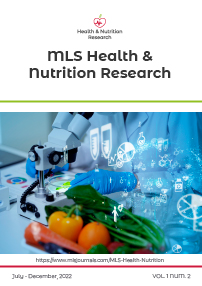Vol 1. Núm. 2 (2022)
Published 2023-05-03
Full Issue
Nowadays the metabolic variations are one of the most suffered illness in the world. Therefore, the investigation of the study about the influence of intake time in the metabolism of a nutrient, it is gaining importance for the development and applications on new treatments as far as these diseases are concerned. This bibliographic review, through an in-depth bibliographic search in different databases, has allowed us to obtain several files, documents, articles and researches that have been used for the analysis, development and execution of the current article. The glucose molecule has more pronounced levels in the afternoon versus the morning, due to the decreased insulin activity through the day. Most lipids show their highest levels in the morning, except for triglycerides showing them in the afternoon. Regarding proteins, more study is needed for their knowledge in this appearance. More research is required to obtain a better conclusion. Even so, it can be concluded that the time of intake is a factor that affects the rhythmicity of metabolic processes, interfering and modifying the activity and response of nutrients.
Elevated circulating levels of branched-chain amino acids (BCAA) have been described as a strong predictor of type 2 diabetes mellitus (DM2). Therefore, the main objective is to evaluate whether a diet rich in these amino acids poses a risk for the development of DM2. Material and methods: This bibliographic review was based on scientific articles selected from different databases. A total of 23 articles were studied in depth. Results and discussion: Higher intake of BCAA has shown a positive association with DM2, especially if it comes from foods of animal origin; similarly, its selective restriction improves the pathophysiology of DM2, without compromising the intake of other essential nutrients. In contrast, BCAA supplementation protocols do not have negative health implications. Conclusion: BCAA intake does appear to be associated with an increased risk of DM2; however, this association cannot be studied in isolation; rather, it should be considered part of a complex interaction of dietary components, in which the nutritional food quality acquires an essential role.
Nutrition is a transversal axis for learning and academic achievement. The COVID-19 confinement forces us to generate new strategies that allow us to know this relationship between nutrition and academic performance, with the intention of improving the achievement of university students. To provide some considerations that allow us to know the relationship between healthy life habits, learning and academic performance in university students. This work corresponds to a documentary design. Studies on eating behavior, healthy life habits and their relationship with school performance and learning processes in university students reported. The studies found show that eating patterns in university students been modified during COVID-19 confinement, and that physical activity levels have decreased. In another sense, school achievement perceived to be lower than expected and with socioeconomic gaps that have repercussions on university students' learning. In addition, nutritionists should be responsible and designated by the countries to generate this reeducation and modification in school curricula for the promotion of healthy lifestyle habits.
The low-carb diet has been studied, as it has how insignificant results in the benefit of weight reduction, as it is composed mostly of protein sand natural fats with low inflammatory potential, also help introduce and combat fluid retention. This diet combined with strength training could help with muscle growth as well as reducing body fat. This study aimed to analyze the effect of a low-carb diet on the body composition of body builders submitted to strength training. Methodology: The sample consisted of 24 male individuals, non-athletes, aged between 19 and 34 years, with training experience. Participants were divided in to two groups, where in one group was submitted strength training with a norms caloric, norm proteic, norms lipids can normo glycidic diet and these cond group was submitted tostrength training with a lowcarb, hypoglycemic, hyperproteic, hyperlipidic diet, during the period of four weeks. Results: When comparingthe body composition of the group with thelow-carbintervention in relation to the control group, no significant differences were observed regarding the data of body fat percentage, lean mass percentage, body mass index. Conclusion: Given the previous evidence on the low-carbdietary strategy, fourth restudies in this area are suggested toob tain new resultsand conclusions.
To analyze the effect of bariatric surgery, physical activity and weight regain on the long-term prevalence of metabolic risk factors using telemedicine. Observational study with retrospective data collection. Participated in the study 84 individuals submitted to bariatric gastric bypass surgery with follow-up of more than five years. Data collection was performed by telemedicine to which data from the patients' clinical process were added. An evolutionary analysis was performed regarding health data and associated comorbidities, namely metabolic risk factors (diabetes, dyslipidemia and mean blood pressure) at baseline (before surgery), one year and five years after surgery. We observed a relative improvement in the values of metabolic risk factors one year after surgery, which was maintained at five years after surgery with statistically significant values (p <0.007). The evolution of the prevalence of metabolic risk factors after surgical intervention is not influenced by weight gain or physical activity. All the comorbidities present a decrease with significance to the 1st and 5th year, related to the surgery itself, regardless of weight gain and the practice of physical activity, which confirms the efficacy of surgery as the most effective factor in the treatment of the comorbidities. E-health is a good way to monitor, in the long term, the evolution of patients undergoing bariatric surgery. We did not obtain a relationship between metabolic syndrome and physical activity or weight gain.
Non-alcoholic fatty liver disease (NAFLD) is becoming more prevalent and it is the leading worldwide liver disease. The main aim of this essay is to compare new dietary-nutritional strategies, such as the Mediterranean diet and omega-3 polyunsaturated fatty acids, to determine which is more effective as a treatment for this disease. To evaluate which nutritional management is more effective as a treatment for non-alcoholic fatty liver, whether supplementation with omega 3 or a Mediterranean diet. A bibliographic review was carried out, for which several scientific articles were consulted and selected from various databases, documents and the online information service provided by the National Library of Medicine of the United States (MedlinePlus), thus obtaining a total of 17 studies belonging to the Pubmed database, which were analyzed in depth.Results and Both the Mediterranean diet and supplementation with omega-3 polyunsaturated fatty acids promote benefits on the clinical characteristics of patients with fatty liver. Following a Mediterranean diet seems to have greatest benefits in the treatment of NAFLD by improving the clinical characteristics of the disease such as hepatic steatosis, inflammation, fibrosis and non-alcoholic steatohepatitis, in addition to metabolic syndrome.












